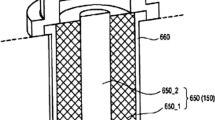Abstract
In high-pressure die casting component, shrinkage defects plays a major role in leakage of fluid from components; therefore, it becomes necessary to predict the exact location of the shrinkage defect to reduce its intensity to an acceptable level. Nowadays, a localized squeezing process is one of the popular ways of reducing the shrinkage defect in high-pressure die casting components. Squeeze pins can be used to compensate for shrinkage defects in these components. The main reason for the formation of shrinkage porosity at the critical location of a given component is large and poorly fed hot spot. In this paper, shrinkage defects are reduced from level III to level I by determining optimum values of squeeze pin parameters by DOE and flow simulation, obtained results are implemented in order to test and verify effectiveness of the method. An excellent agreement is indicated for the simulation result and the experimental results.











Similar content being viewed by others
References
E. Niyama, T. Uchida, M. Morikawa, S. Saito, Am. Foundrymen’s Soc. Int. Cast. Met. J. 7(3), 52–63 (1982)
S. Polyakov, A. Korotchenko, J. Bast, Use of the Niyama criterion to predict porosity of the mushy zone with deformation. Arch. Found. Eng. 11, 131–136 (2011)
E. Anglada, A. Meléndez, I. Vicario, E. Arratibel, G. Cangas, Simplified models for high pressure die casting simulation. Proc. Eng. 132, 974–981 (2015)
H. Yuanyuan, J. Xie, Z. Liu, Q. Ding, W. Zhu, J. Zhang, W. Zhang, CA Method with machine learning for simulating the grain and pore growth of aluminum alloys. Comput. Mater. Sci. 142, 244–254 (2018)
S. Singh, A.I. Kanli, S. Sevgen, A general approach for porosity estimation using artificial neural network method: a case study from Kansas gas field. Stud. Geophys. Geod. 60(1), 1–11 (2016)
I. Ghosh, S.K. Das, N. Chakraborty, An artificial neural network model to characterize porosity defects during solidification of a356 aluminum alloy. Neural Comput. Appl. 25(3), 653–662 (2014)
R. Ashiri, F. Karimzadeh, B. Niroumand, On effect of squeezing pressure on microstructural characteristics heat, treatment response and electrical conductivity of an Al Si Mg Ni Cu alloy. Mater. Sci. Technol. 30, 1162–1169 (2014)
A.R. Adamane, L. Arnberg, E.E. Fiorese, G. Timelli, F. Bonollo, Influence of injection parameters on the porosity and tensile properties of high pressure die cast Al Si alloys: a review. Am. Found. Soc. 9, 43–53 (2015)
M.R. Bodhayana, N. Ramesha, Tool design for pressure dies casting of Housing Component. Int. J. Theory Appl. Res. Mech. Eng. 3, 30–33 (2014)
H.M. ManjunathSwamy, J.R. Nataraj, C.S. Prasad, Design optimization of gating system by fluid flow and solidification simulation for front axle housing. Int. J. Eng. Res. Dev. 4, 83–88 (2012)
Y. Ling, J. Zhou, H. Nan, Y. Yin, X. Shen, A shrinkage cavity prediction model for gravity castings based on pressure distribution: a casting steel case. J. Manuf. Process. 26, 433–445 (2017)
S. Yue, G. Wang, F. Yin, Y. Wang, J. Yang, Application of an integrated CAD/CAE/CAM system for die casting dies. J. Mater. Process. Technol. 139, 465–468 (2003)
H.-J. Kwon., H.-K. Kwon: Computer aided engineering (CAE) simulation for the design optimization of gate system on high pressure die casting (HPDC) process, in Robotics and Computer–Integrated Manufacturing, pp. 1–7 (2018)
KCh. Apparao, A.K. Birru, Optimization of Die casting process based on Taguchi approach. Mater. Today: Proc. 4, 1852–1859 (2017)
B.H. Hu, K.K. Tong, X.P. Niu, I. Pinwill, Design and optimization of runner and gating systems for the die casting of thin-walled magnesium telecommunication parts through numerical simulation. J. Mater. Process. Technol. 105, 128–133 (2000)
P. Vispute, D. Chaudhari, Utilizing flow simulation in the design phase of a casting die to optimize design parameters and defect analysis. Mater. Today Proc. 4, 9256–9263 (2017)
A.R. Adamane, L. Arnberg, E. Fiorese et al., Influence influence of injection parameters on the porosity and tensile properties of high-pressure die cast al-si alloys- a review. Int. J. Metalcast. 9, 9–43 (2015)
H. Dini, N.-E. Andersson, Anders E.W. Jarfors, Effect of process parameters on distortion and residual stress of high pressure die cast AZ91D components. Int. J. Metalcast. 12–3, 487–497 (2018)
Author information
Authors and Affiliations
Corresponding author
Rights and permissions
About this article
Cite this article
Borlepwar, P., Biradar, S. Study on Reduction in Shrinkage Defects in HPDC Component by Optimization of Localized Squeezing Process. Inter Metalcast 13, 915–922 (2019). https://doi.org/10.1007/s40962-018-00295-9
Published:
Issue Date:
DOI: https://doi.org/10.1007/s40962-018-00295-9




